From the 15th century through the 18th century, the Spanish Empire controlled vast territories across the globe where they set up a network of colonies. These included most of South America, all of Central America, Mexico, and most of the Caribbean islands.
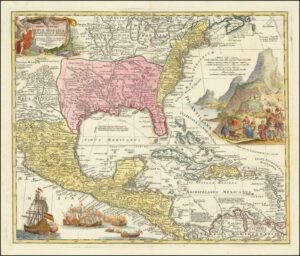 The Spanish also laid claim to a substantial portion of North America. Known as “The New World”, these territories possessed seemingly unlimited resources, especially gold and silver which Spain used to finance its conquests, military campaigns, and maintain its global dominance.
The Spanish also laid claim to a substantial portion of North America. Known as “The New World”, these territories possessed seemingly unlimited resources, especially gold and silver which Spain used to finance its conquests, military campaigns, and maintain its global dominance.
Gold was the most sought after commodity of all and once a colony had acquired enough of it, the colonial mints would be tasked to melt it down and convert it mostly into coins before it was shipped back to Spain.
Old World Spanish Coinage Under King Philip IV (1621-1665)
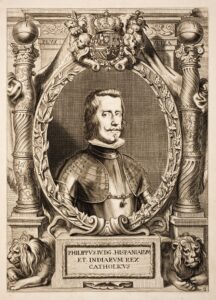 By the time Philip IV (1605-1665) became King, his predecessors had established trade routes with the New World. Each year, tons of gold, silver, and other commodities were being transported from the colonies to Spain by flotillas of heavily armed galleons and merchant vessels.
By the time Philip IV (1605-1665) became King, his predecessors had established trade routes with the New World. Each year, tons of gold, silver, and other commodities were being transported from the colonies to Spain by flotillas of heavily armed galleons and merchant vessels.
These ships would travel thousands of miles and encounter countless perils to get their precious cargo to the port City of Seville. Once the treasure laden ships arrived in Seville, the New World gold coins were remelted and converted into standard Spanish Escudos of equivalent denominations and weight.
Typically, New World gold coins were minted in Mexico, Peru, or Columbia in denominations of 1,2,4, and 8 “Escudos de Oro” or “gold shields”. The Royal Mint of Seville or “Real Casa de la Moneda”, handled the bulk of the New World gold. The purity was to be 22 carats and the weight of each coin denomination was as follows:
8 Escudos = 27.06 grams
4 Escudos = 13.53 grams
2 Escudos = 6.77 grams
1 Escudo =3.34 grams
The “Cabo De Barra” of Seville
Most of the coins minted in Seville during the reign of Philip IV were hammer struck versus being mechanically milled. This type of hammer struck coin is commonly known as a “Cob”, which is an abbreviated Spanish term for “cabo de barra” or “end of the bar”. This name is likely in reference to how these coins were made from thin straps of gold poured into shallow molds and then cut into pieces before being struck with a hammer and die.
All Spanish mints had an overseer known as an assayer whose job it was to make sure the coins were of the proper weight, fineness, and that the dies displayed the design elements the king wanted on his coinage. Quality control was not a high priority at the mints and seeing as cobs were irregular in shape and size, it is extremely rare to find one that displays the complete die design or legend on both sides of the coin.
Sometimes the flan or planchet (a round blank or disk that is ready to be struck as a coin) was struck off-center which would only allow a small portion of the legend lettering on the die to show. Then there were worn out dies where the lettering was flattened out to the point where the characters were no longer legible.
In some cases, the dies were larger than the planchet, which made it impossible for all the design elements to impress on the coin. Lastly, if the coin was overweight, the assayer would clip off small pieces until it was the correct weight. This clipping often removed the lettering or date from the edges.
The Unique Design Elements for Philip IV Escudos Minted in Seville
The design elements embodied on four escudos minted at the Seville mint during the reign of Philip IV are some of the most beautiful gold cobs Spain ever produced.
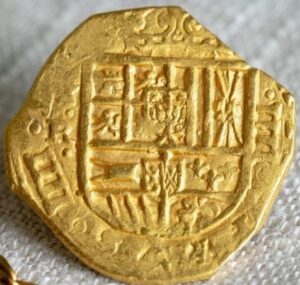 The obverse or “shield side” shows the typical Habsburg shield with a crown over the shield. The shield contains symbols that represent different kingdoms under Spanish rule. These include Castile and Leon represented by castles and lions, Aragon and Sicily, Granada, Austria, ancient Burgundy and modern Brabant, Flanders and Tyrol, with the little shield of Portugal near the bottom.
The obverse or “shield side” shows the typical Habsburg shield with a crown over the shield. The shield contains symbols that represent different kingdoms under Spanish rule. These include Castile and Leon represented by castles and lions, Aragon and Sicily, Granada, Austria, ancient Burgundy and modern Brabant, Flanders and Tyrol, with the little shield of Portugal near the bottom.
The legend on the shield side is in Latin and reads “PHILIPPVS IIII D. G.”, which is an abbreviation for “PHILIPPVS IIII DEI GRATIA”. The translation in English is “Philip the 4th by the Grace of God”.
One interesting feature of the dies used during the reign of Philip IV, is the use of the Roman numeral “IIII” shown as four Roman numeral ones instead of “IV” for the kings ordinal or regnal number. Many believe that the use of “IIII” was more visually balanced and easier to read on coins and clocks of the period.
The preference for “IIII” over “IV” was not unique to Spain—it was used in other European mints, including British Coins from the reign of King George IV. Rather than many of the coins minted during his reign showing “George IV”, they often read as “ George IIII” as the stylistic choice. Here is an example of a British Farthing where a “IIII” was once again used: https://www.pcgs.com/cert/32841136
The letters to the left of the shield are most commonly seen as an “S” over an “R”, although there is one known and very rare variety minted in 1646 that shows an “S” over the assayer’s initial “A”. (This initial possibly belongs to Antonia de Haro Guzmán, Countess of Luna and Duchess of Medina Sidonia. She was the owner of the assayer’s position, who appointed Manuel Duarte to perform her duties.) Here is what this coin looks like: https://onzasmacuquinas.com/4rafa111.php?anverso=064FIV-So1644-3ASev1.jpg
The “S” represents the mint being Seville and the “R” represents the first letter in the assayer’s last name, which in this case is Geronimo Rodriguez. Geronimo Rodriguez was the assayer at the Seville mint from 1619-1648.
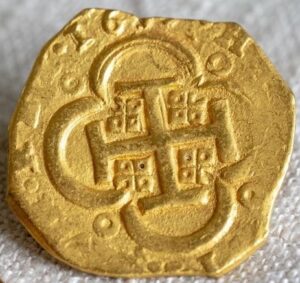 The reverse or “cross side” is very significant and shows a bold Jerusalem Cross surrounded in a quatrefoil with four outer rings where the lobes meet.
The reverse or “cross side” is very significant and shows a bold Jerusalem Cross surrounded in a quatrefoil with four outer rings where the lobes meet.
The Jerusalem cross (also known as a “five-fold Cross”, or “cross-and-crosslets”) is a heraldic cross and Christian cross variant consisting of a large cross potent surrounded by four smaller Greek crosses, one in each quadrant.
 Although the history of the Spanish was dark, as well as all civilizations for that matter, the symbolism of the five-fold cross represents the Five Wounds of Christ at his crucifixion and the sacrifice he made to deliver humanity from evil and eternal death: In the Book of Matthew Chapter 27, verses 32-54 states;
Although the history of the Spanish was dark, as well as all civilizations for that matter, the symbolism of the five-fold cross represents the Five Wounds of Christ at his crucifixion and the sacrifice he made to deliver humanity from evil and eternal death: In the Book of Matthew Chapter 27, verses 32-54 states;
“The soldiers were going out of the city with Jesus. They saw a man from Cyrene named Simon, and they forced him to carry Jesus’ cross. 33 They came to the place called Golgotha. (Golgotha means “The Place of the Skull.”) 34 There the soldiers gave Jesus some wine mixed with gall. But when he tasted it, he refused to drink it. 35 The soldiers nailed Jesus to a cross. Then they threw dice to divide his clothes between them. 36 The soldiers stayed there to guard him. 37 They put a sign above his head with the charge against him written on it: “ this is Jesus, the king of the Jews.” 38 Two criminals were nailed to crosses beside Jesus—one on the right and the other on the left. 39 People walked by and shouted insults at Jesus. They shook their heads 40 and said, “You said you could destroy the Temple and build it again in three days. So save yourself! Come down from that cross if you really are the Son of God!” 41
 The leading priests, the teachers of the law, and the older Jewish leaders were also there. They made fun of Jesus the same as the other people did. 42 They said, “He saved others, but he can’t save himself! People say he is the king of Israel. If he is the king, he should come down now from the cross. Then we will believe in him. 43 He trusted God. So let God save him now, if God really wants him. He himself said, ‘I am the Son of God.’” 44 And in the same way, the criminals on the crosses beside Jesus also insulted him. 45 At noon the whole country became dark. The darkness continued for three hours. 46 About three o’clock Jesus cried out loudly, “Eli, Eli, lema sabachthani?” This means “My God, my God, why have you left me alone?” 47 Some of the people standing there heard this. They said, “He is calling Elijah.” 48 Quickly, one of them ran and got a sponge. He filled the sponge with sour wine and tied the sponge to a stick. Then he used the stick to give the sponge to Jesus to get a drink from it. 49 But the others said, “Don’t bother him. We want to see if Elijah will come to save him.” 50 Again Jesus cried out loudly and then died. 51 When Jesus died, the curtain in the Temple was torn into two pieces. The tear started at the top and tore all the way to the bottom. Also, the earth shook and rocks were broken. 52 The graves opened, and many of God’s people who had died were raised from death. 53 They came out of the graves. And after Jesus was raised from death, they went into the holy city, and many people saw them. 54 The army officer and the soldiers guarding Jesus saw this earthquake and everything that happened. They were very afraid and said, “He really was the Son of God!” https://www.biblegateway.com/passage/?search=Matthew%2027%3A32-56&version=ERV;KJV
The leading priests, the teachers of the law, and the older Jewish leaders were also there. They made fun of Jesus the same as the other people did. 42 They said, “He saved others, but he can’t save himself! People say he is the king of Israel. If he is the king, he should come down now from the cross. Then we will believe in him. 43 He trusted God. So let God save him now, if God really wants him. He himself said, ‘I am the Son of God.’” 44 And in the same way, the criminals on the crosses beside Jesus also insulted him. 45 At noon the whole country became dark. The darkness continued for three hours. 46 About three o’clock Jesus cried out loudly, “Eli, Eli, lema sabachthani?” This means “My God, my God, why have you left me alone?” 47 Some of the people standing there heard this. They said, “He is calling Elijah.” 48 Quickly, one of them ran and got a sponge. He filled the sponge with sour wine and tied the sponge to a stick. Then he used the stick to give the sponge to Jesus to get a drink from it. 49 But the others said, “Don’t bother him. We want to see if Elijah will come to save him.” 50 Again Jesus cried out loudly and then died. 51 When Jesus died, the curtain in the Temple was torn into two pieces. The tear started at the top and tore all the way to the bottom. Also, the earth shook and rocks were broken. 52 The graves opened, and many of God’s people who had died were raised from death. 53 They came out of the graves. And after Jesus was raised from death, they went into the holy city, and many people saw them. 54 The army officer and the soldiers guarding Jesus saw this earthquake and everything that happened. They were very afraid and said, “He really was the Son of God!” https://www.biblegateway.com/passage/?search=Matthew%2027%3A32-56&version=ERV;KJV
While the symbol of the five-fold cross appears to originate in the 11th century, its association with the Kingdom of Jerusalem dates to the second half of the 13th century. The legend on the cross side reads in Latin “HISPANIARVM·REX”, which being translated means: “King of Spain”. After the word “REX” and before the word “HISPANIARVM “ is where a date is positioned.
As no known examples exist of a four escudos cob minted in Seville that displays the entire legend, we can only see what the legend was supposed to look like by comparing silver coins minted during King Philip’s reign as a reference.
Here is an example, of a milled 8 Reales minted at the Segovia mint during the reign of King Philip IV. This coin displays what the complete legend should look like on each side of the Seville four escudos.
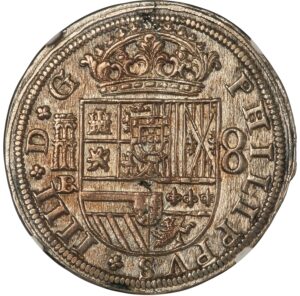 |
 |
Sources:
1. Spanish Colonization of The Americas: https://en.wikipedia.org/wiki/Spanish_colonization_of_the_Americas
2. Spanish Empire by New World Encyclopedia https://www.newworldencyclopedia.org/entry/Spanish_Empire
3. Spanish Treasure Fleets by World History Encyclopedia https://www.worldhistory.org/Spanish_Treasure_Fleets/
4. Coat of Arms of Spain: https://en.wikipedia.org/wiki/Coat_of_arms_of_Spain
5. Jerusalem Cross: https://en.wikipedia.org/wiki/Jerusalem_cross
Written by Sean Scott. For more information, please contact Sean@CommodoreCoins.com.

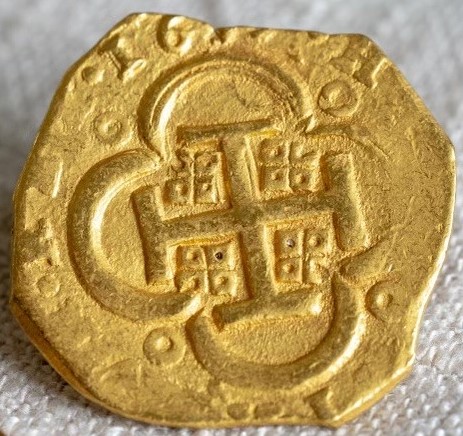
Leave a Reply